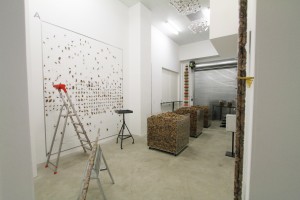
The Incredible Leaf Lab As Art
Plunging your hands into a huge tub filled with dried leaves is an incredibly visceral experience. Even the smell as they are tossed and upturned can bring back vivid memories, for those who remember playing in newly raked leaf piles. That’s just one of the pleasures in visiting Karen Rifas’ “laboratory” of leaves at the de la Cruz Collection.
Both adults and children are welcome here, to discover the secret lives of leaves as it were and to educate ourselves about our disappearing forests and eco-systems. It’s best if artist and lab director Rifas is on hand as a guide (which she likely will be on weekends, but call first), it makes the trip all the more fun and fascinating.
She might first suggest that you pick out two matching leaves from the three huge piles, held in transparent containers. The millions of leaves have been collected from the artist’s backyard over the years, and include both oak and pine. Of course, no two leaves are completely alike, but it’s interesting to find that out. Rifas has small plastic bags for you after you think you’ve found a pair (or just a leaf that grabs your attention), and you can pin it on her wall of specimens.
Or fill small containers with leaves and make a sculpture if you want. Rifas has also “baked” some leaf pies, for future studies.
This is the way the gallery describes the leaf lab installation, called “Abandoned:” “The installation references our twenty-first century need to sustain, organize and classify, be it our DNA, print material or even our art artifacts. There is an obvious interdisciplinary consciousness in the art world to discuss environmental issues and this installation touches on many of these concerns. The participatory exhibition becomes an audience collaborative as visitors effect the preservation and classification of those subsequent protectors of beauty.”
Rifas is known for her site-specific, woven-leaf installations (she shows at Bernice Steinbaum among other places and is a professor at the New World School of the Arts). On this Saturday visit, she explains that the leaves in the lab have been disinfected (“nobody wanted a bug problem!”), but they are still waxy and pliable and fun to play with. The more you dig around, the more you find a such a wide diversity of “life” in the piles, just like one might when digging around a little piece of forest. There are sticks and bulbs, tiny clover-like shapes and large, classic beauties. Look up, and leaf shadows dance on the ceiling, courtesy of calculated lighting. Also hanging high from the ceiling are little folded packets of leaf strings, which Rifas will set free and let dangle all the way to the floor sometime toward the end of the exhibit (it will run through September).
Rifas collected other, non-natural objects for shelves that on first glance look lined with laboratory equipment. On closer inspection, the found metal objects reveal themselves to be hair curlers or rubber stamp holders. It’ a really a lovely piece of artwork.
Conceits such as this artificial laboratory don’t always work in lesser hands, but Rifas pulls this off beautifully. It helps that she clearly enjoys this work, and wants you to as well (during our visit, a young boy worked diligently on filling a long, transparent tube with a variety of leaves, and discovered and displayed a matching pair).
“Abandoned” is also a nice first-year exhibit for the de la Cruz Collection, proving that it truly does wants to be an open and interactive space for the community.
“Abandonded” at the de la Cruz Collection, 23 N.E. 41st St., Miami; 305-576-6112; [email protected] (call for more details or to set up a lab tour; the Collection is on a short break till August); www.delacruzcollection.org.
Recent Content
-
Artsarticle ·
-
Artsarticle ·
-
Artsarticle ·

